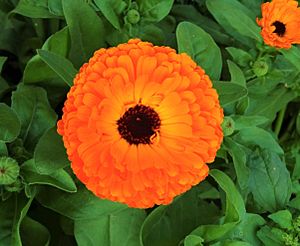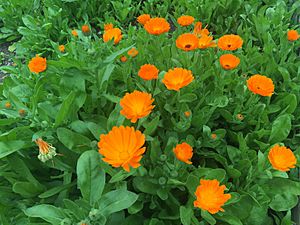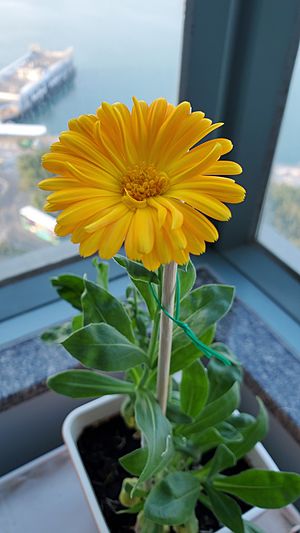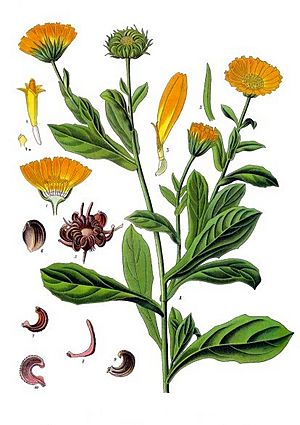Pot marigold facts for kids
Quick facts for kids Pot marigold |
|
|---|---|
 |
|
 |
|
| UBC Botanical Garden | |
| Scientific classification | |
| Genus: |
Calendula
|
| Species: |
officinalis
|
| Synonyms | |
|
|
Calendula officinalis (pot marigold, ruddles, common marigold, garden marigold), is a plant in the genus Calendula of the family Asteraceae. It is probably native to India. It was the state flower of Junagadh and Bantva-Manavadar State, now part of Gujarat.
Contents
Cultivation
Calendula officinalis can be grown easily in sunny locations in most kinds of soils. Although perennial, it is commonly treated as an annual, particularly in colder regions where its winter survival is poor, and in hot summer locations where it also does not survive.
Calendulas are considered by many gardening experts among the easiest and most versatile flowers to grow in a garden. In temperate climates, seeds are sown in spring for blooms that last throughout the summer and well into the fall. In areas of limited winter freezing, seeds are sown in autumn for winter color. Plants will wither in subtropical summer. Seeds will germinate freely in sunny or half-sunny locations, but plants do best if planted in sunny locations with rich, well-drained soil. Pot marigolds typically bloom quickly from seed (in under two months) in bright yellows, golds, and oranges.
Leaves are spirally arranged, 5–18 cm (2.0–7.1 in) long, simple, and slightly hairy. The flower heads range from pastel yellow to deep orange, and are 3–7 cm (1.2–2.8 in) across, with both ray florets and disc florets. Most cultivars have a spicy aroma. It is recommended to deadhead (remove dying flower heads) the plants regularly to maintain even blossom production.
Uses
Pot marigold florets are edible. They are often used to add colour to salads or added to dishes as a garnish instead of saffron. The leaves are edible but are often not palatable. They have been used as a herb and in salads.
The flowers were used in Ancient Greek, Roman, Middle Eastern, and Indian cultures as a medicinal herb and a dye for fabrics, foods, and cosmetics. They are also used to make oil that protects the skin.
Images for kids
See also
 In Spanish: Calendula officinalis para niños
In Spanish: Calendula officinalis para niños





